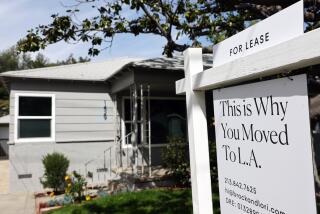The great condo divide
- Share via
NOT since Archie and Meathead went toe to toe in “All in the Family” has generational conflict reared its ugly head this high.
As people who have bought into condominium projects are discovering, a battle of priorities among different age groups is raging on the common-ownership front. After all, just because those lofts are being marketed to a younger crowd doesn’t mean they are the only ones buying.
Battle lines over maintenance, special assessments and day-to-day operations are frequently drawn along generational divides. Should money be spent on putting in park benches and planting more flowerbeds, or on repaving the tennis courts? Should the swimming pool stay open until 10 p.m. or be locked up at 7 p.m. as a noise-control measure? Should association funds be used to install an on-site gym or replace the siding?
Ceil Ross, vice president and treasurer of a homeowners association of 15 units in Sherman Oaks, said about three-quarters of her complex is owned by people in their 60s to 80s. The rest are younger residents, some with young families. The building, now 20 years old, is starting to show signs of age.
“It’s hard on the people who are on fixed incomes to come up with the money for special assessments to cover emergency maintenance problems,” said Ross, 80, let alone pay for extras they consider optional.
Some of the younger residents want the board to paint and spruce up the common areas, she said, and older owners are resisting because of the costs. And since older residents often make up the majority of boards, they may feel that those who do the work should have more sway in determining spending.
“It’s the older, retired people who have the time to volunteer their services on the board,” she added. “We nominate the younger people every year, but they’re too busy and don’t want the responsibility.”
When disagreements about what’s an upgrade and what’s maintenance continue without resolution, the effect on the property can be seen.
Mike McCall, 59, a real estate investor and agent with White House Properties in Woodland Hills, owned a condo in a Rancho Mirage complex that he said was deteriorating for lack of maintenance: the pool storage room had a leaking ceiling, posts on the patio by the pool had dry rot, and the complex needed painting.
“I’d go to a board meeting, and three of the board members were original owners,” McCall recalled. “I heard one guy say, ‘I’m not going to put any more money into this place because it’s going to my kids when I die, and they can do what they want with it.’ That attitude doesn’t help the homeowners living there or those who want to sell.”
Alan Entin, past president of the division of family psychology in the American Psychological Assn., specializes in intergenerational relationships in his Richmond, Va., practice. People in every generation want to learn for themselves and do things their own way, he said, so differences are to be expected.
“You’re always going to have differences over things in a building,” Entin said, whether the issue is taste in decor or maintenance. “Older homeowners just want to be heard and don’t want to be dismissed by young folks.
“Older people may not have the income to do things younger people want done, and that needs to be understood. It’s a two-way street in terms of listening to each other.”
Generational differences often crop up around use restrictions, dictated by each association’s covenants, conditions and restrictions (CC&Rs;).
“If you’re young and want to listen to your music, and have people come over, the older residents complain about the noise and having too many cars around,” said Ellen Hirsch de Haan, 60, a past president of the Community Associations Institute, an industry group of homeowners, managers and professionals providing education and resources to associations.
Mark Stewart, broker-owner of JML Properties in Calabasas, noted, “There’s natural conflict in every homeowners association, and since the 1994 earthquake, people’s ideas about how to handle HOAs have changed.”
Because many condo associations at that time didn’t have nearly enough in their reserve funds to cover earthquake damage, older owners now tend to want higher reserves as a cushion against future problems, he said.
Not everyone is thinking big picture, however.
Bob Miller, an owner and board member at a 65-unit Encino condominium complex, said he believes most people in condos tend to think only of the value of their individual unit and not the value of the total project.
“You have to accept that when you live in a condo, you lose some of the rights and privileges you have in a free-standing home,” said Miller, 77. “If you’re not adaptable, and don’t have the right personality for living with rules and regulations, you’ll have a problem living in a condo.”
Sooner or later, homeowners who choose a condominium lifestyle will have to deal with the politics of communal living.
“Condos are like independent villages, and the governors are the board of directors,” said Raymond Kaiser, an attorney with Long Beach-based HOA Mediation Services, which charges $300 an hour with a two-hour minimum for mediation sessions. “Sometimes the problems can be solved politically by consensus-building. When they’re not, we talk about the law and propose possible areas of compromise. We have people talk face to face, then separate the two parties into two conference rooms and do shuttle diplomacy. The mediator becomes a neutral party with the authority to speak for both sides.”
Common generational conflicts Kaiser said he sees in his practice include noise issues, with older residents desiring quiet and contending with families with young children or teenagers who want playgrounds and skateboard ramps.
There are also lifestyle divides. “A lot of young people now are into ‘green’ styles of living, with low-water-usage plants, where older people may want roses and higher-water-usage plants,” Kaiser said. “Young people may think smoking should be banned from the common areas, or want an updated look to the building, where older residents want a different architectural style.”
Not everyone is willing or able to spend $600 or more to resolve a generational dispute.
Residents of L.A. County who don’t want to pay a lawyer can receive mediation services through the Dispute Resolution Program in the city attorney’s office for free.
Call (213) 485-8324, go to www.lacity.org/mediate or write by e-mail to mediate@lacity.org.
For other mediation programs throughout California, contact the California Department of Consumer Affairs at www.dca.ca.gov.
More to Read
Sign up for Essential California
The most important California stories and recommendations in your inbox every morning.
You may occasionally receive promotional content from the Los Angeles Times.






